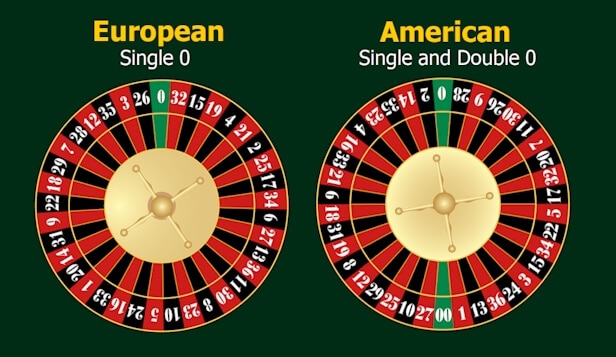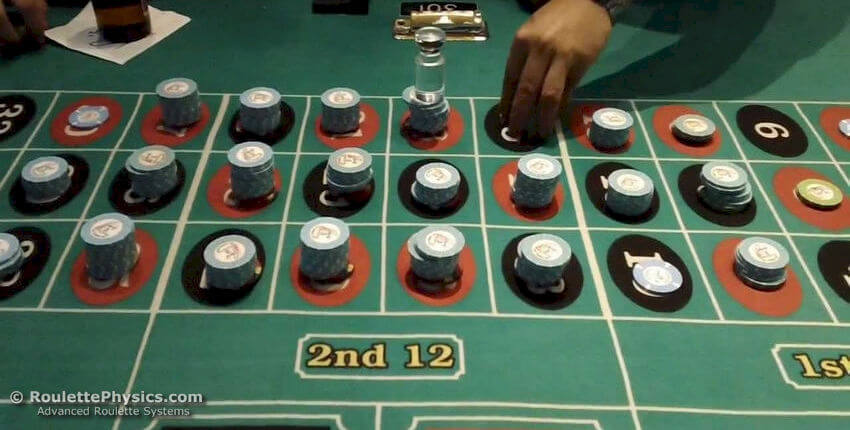The odds and payouts are slightly different for each wheel type, and are listed below. If you are looking for professional roulette systems that work, see the top 5 roulette systems that work.
Roulette Odds and Payouts
| Bet | Payout | European Roulette Odds (Chance of Winning) | European Roulette House Edge | American Roulette Odds (Chance of Winning) | American Roulette House Edge |
| Reds / Blacks (colour) | 1:1 | 48.65% | 2.7% | 47.37% | 5.26% |
| Evens / Odds | 1:1 | 48.65% | 2.7% | 47.37% | 5.26% |
| Lows / Highs (1-18 / 19-36) | 1:1 | 48.65% | 2.7% | 47.37% | 5.26% |
| Dozens | 2:1 | 32.43% | 2.7% | 31.58% | 5.26% |
| Columns | 2:1 | 32.43% | 2.7% | 31.58% | 5.26% |
| 6 Numbers (6 line) | 5:1 | 16.22% | 2.7% | 15.79% | 5.26% |
| 5 Numbers (top line) | 6:1 | – | – | 13.16% | 7.89% |
| 4 Numbers (square) | 8:1 | 10.81% | 2.7% | 10.53% | 5.26% |
| 3 Numbers (street) | 11:1 | 8.11% | 2.7% | 7.89% | 5.26% |
| 2 Numbers (split) | 17:1 | 5.41% | 2.7% | 5.26% | 5.26% |
| 1 Number (straight) | 35:1 | 2.70% | 2.7% | 2.63% | 5.26% |
|
|||||
Types Of Roulette Bets:
The two main types of bets are “inside” and “outside”. There are different betting limits for each type of bet. Usually you can bet much higher on outside bets. This is for a few reasons, but mainly because the payouts are much higher on inside bets.

The Types of Roulette Bets, Roulette Odds and Chip Placement
(1) Straight (1 number): 35-1 payout (pays your original bet PLUS 35 units). The example covers number 2.
(2) Split (2 numbers): 17-1 payout (pays your original bet PLUS 17 units). The example covers numbers 2 & 6.
(3) Street (3 numbers): 11-1 payout (pays your original bet PLUS 11 units). The example covers 7, 8 & 9.
(4) Square (4 numbers): 8-1 payout (pays your original bet PLUS 8 units). The example covers 8, 9, 11 & 12.
(5) Six Line (6 numbers): 5-1 payout (pays your original bet PLUS 5 units). The example covers numbers 13, 14, 15, 16, 17 & 18.
(6) Colours (18 numbers): 1:1 payout (pays your original bet PLUS 1 unit). The example covers all black numbers.
(7) Dozens (12 Numbers): 2-1 payout (pays your original bet PLUS 2 units). The example covers numbers 13 to 24 (the second dozen).
(8) Highs / Lows (1-18 or 19-36): 1-1 payout (pays your original bet PLUS 1 unit). The example covers numbers 19 to 36.
(9) Odds/Evens (18 numbers): 1-1 payout (pays your original bet PLUS 1 unit). The example covers all odd numbers.
(10) Columns (12 numbers): 2-1 payout (pays your original bet PLUS 2 units). The example covers numbers 2, 5, 8, 11, 14, 17, 20, 23, 26, 29, 32, 35.
Avoiding Common Misconceptions
One of the most common mistakes a roulette player will make is to increase bets after losses, without any consideration to predicting the winning number. It should be obvious that roulette is all about the winning number. And the idea is to bet on the winning number. But almost every roulette system does not even consider why the ball lands where it does. It sounds ridiculous but it’s true. The average roulette bet made by players don’t even consider variables that determine where the ball will land.
For example, a simple system may be to bet on red but increase your bet size after a loss. The theory is that increasing the bet size will allow you to win back any losses. But the reality is you are simply increasing the amount you wager on the next spin. Each spin has no correlation to the following spin, at least not in the way that such a betting system assumes.
Another example is consider 10 reds spinning in a row. One roulette player says “red is on a streak, I must bet red”. Another player says “black is due to spin next, so I’ll bet black”. So who is right? Neither of them. This is because the odds of red or black spinning are still 50/50 (neglecting the existence of zero for now). It’s amazing how every player at the table things either one way or the other when there is a long streak of a particular colour. Meanwhile the casino owner is sitting back rubbing their hands, grateful that the players have no idea that the illusion of streaks or due events is all in the player’s head.
Race Track Bets

Not all roulette tables offer race track bets. The race track enables players to make bets based on specific segments of the roulette wheel. The rules for use of the race track vary between casinos. Also the wording sometimes varies between race tracks, although usually the same areas for bets are available.
Series 5/8: A bet on the orange “Series 5/8” area is the following:
Splits (2 numbers): 5 & 8, 10 & 11, 13 & 16, 23 & 24, 27 & 30, 33 & 36
Orphelins: A bet on the green “Orphelins” area is:
Straight (1 number): 1
Splits (2 numbers): 6 & 9, 14 & 17, 17 & 20, 31 & 34
Series 0/2/3: A bet on the orange “Series 0/2/3” area is:
Streets (3 numbers): 0, 2, 3
Splits (2 numbers): 4 & 7, 12 & 15, 18 & 21, 19 & 22, 25 & 28, 26 & 29, 32 & 35.
0-Game: A bet on “0-Game” is:
Straight (1 number): 26
Splits (2 numbers): 0 & 3, 12 & 15, 32 & 35
Neighbor bets: This is a bet on a single number on the race track. If you bet in a real casino, one bet on an number splits the bet amount between 5 numbers. This includes the number you’ve bet, plus the 2 numbers each side of it. If you bet in an online casino, a click on an individual number automatically places one chip on the number, plus one chip on each of the 2 numbers on each side (total 5 numbers and 5 chips).
In some casinos, neighbor bets must be passed to the dealer, who may then inform the pitt boss of your bet. The reasons behind this are varied. Firstly, it helps detect professional players who bet on sectors. And secondly, it makes your bet clear to everyone so there are no misunderstandings. Any misunderstandings about where players wanted to bet would otherwise cause arguments.
What’s The Best Roulette Bet?
The best bet is wherever the ball lands. Duh, right? But let me explain more . . . Firstly, realistically you can’t know exactly what number will win on every spin. But on most wheels, it is at least possible to predict which area the ball will bounce to, and you can have at least better than random accuracy. You need to understand the house edge with roulette is only small, and you only need to have slight accuracy of predictions to put the edge in your favor. You’d think it would be impossible to predict where the ball bounces, and you’d think the dealer’s spin speeds would control it all. But take your time to read this website and understand the principles that make roulette a much more predictable game than you may think.
How Important are Roulette Odds?
The roulette odds simply tell you how often you can expect to win if the accuracy of your bet selection is no better than random. If you apply advantage play methods that use physics to predict the winning number, then the odds change, although generally the player edge becomes the focus.
For example, the odds of winning on a European roulette wheel are 1 in 37 if you bet on a single number. But with a roulette computer device, you could win as often as 1 in 10 spins. So you will have more than tripled your odds of winning, making the typical roulette odds somewhat irrelevant.
Which Bets Have the Best Odds?
The “best odds” of winning is different to the payout and edge. You could bet on every number, and you’d win every time, so your odds of selecting the winning number would be highest. But you’d still actually lose money because you’d be paid an unfair amount. This unfair amount is the “house edge”. So instead of considering the “best odds in roulette”, consider the “house edge”. But as per the above chart, the edge is the same on all bets.
European and American Double 0 Wheel Layouts

The American wheel has both single and double 0 pockets, whereas the European wheel only has a single green 0. The layout of each wheel type is below:
Single-zero (European) wheel: 0,32,15,19,4,21,2,25,17,34,6,27,13,36,11,30,8,23,10,5,24,16,33,1,20,14,31,9,22,18,29,7,28,12,35,3,26
Double-zero (American) wheel: 0,28,9,26,30,11,7,20,32,17,5,22,34,15,3,24,36,13,1,00,27,10,25,29,12,8,19,31,18,6,21,33,16,4,23,35,14,2
The House Edge
The house edge is the normal edge the casino has over players. On the European wheel, it is -2.7% and on the American wheel, it is -5.26%. So the advantage the casino has over players is much greater with the American wheel. However, in either case it’s still only a minor advantage the casino has. But unless the accuracy of the player’s predictions is better than random, this small edge is enough for the casino to reliably profit over the long term. It is inevitable that some players will win in the short-term, but the casino thinks in terms of tens of thousands of spins and thousands of players, not individual players. The only time casinos consider individual players is if they appear to be using a professional roulette system.
Call Bets
Called or announced bets are bets that are made by speaking them, without actually placing the bets. These type of bets are not permitted in all jurisdictions, mostly because it creates opportunities for cheating players to place bets without having any money.
Neighbor Bets
These are typically used by professional players to bet on particular physical sectors of the roulette wheel. Sector bets are the only types of bets that increase the roulette odds for you. For example, a neighbor bet on zero for the European roulette wheel will typically cover numbers 3,26,0,32,15. This is because sector based bets are used in advantage play methods. In particularly the European casinos, a neighbor bet must be given to the dealer, who then announces the bet to the pit boss. From a professional player’s perspective, it is not wise to do this too often as it attracts attention. Neighbor bets are placed on a circular representation of the wheel situated on the betting table, called the race track.
To get the best free roulette systems that really work, see the top 5 proven roulette systems and the video series below. It's the best 100% free information for winning roulette you'll find. It's written by professionals who are really earning a living from roulette. |

